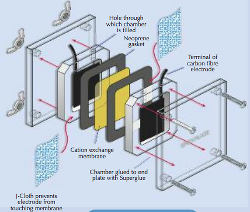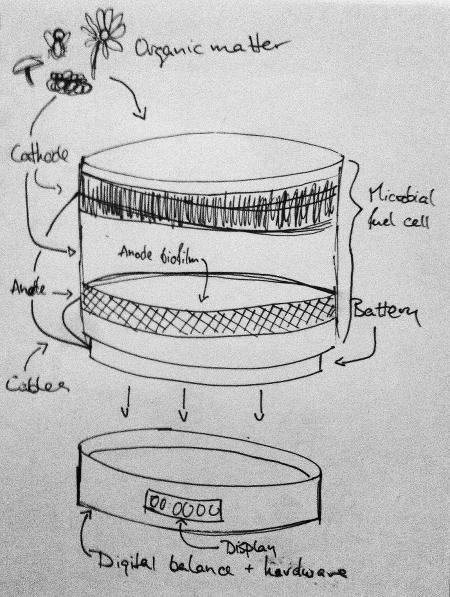The Organic Balance
Over the course of my Master’s, I became strongly interested in the application of critical theory and cultural studies to the study of biotechnology and its associated discourses. As I tend to remain skeptical of this field’s promises – with its disciplinary roots anchored in some cross-hatching between physics/engineering and cybernetics – I decided to imagine for my final project something that would be from the start nothing but an attempt at a failed experiment playfully building upon its most morbid aspects. Away from technics using life as a metaphor, it is life as energy and matter that I want to exploit as my point of departure – quite literally.
As I see it now, the object I would try to build during the term could be referred to as a “life quantifier”. Composed of two pieces – a home-made microbial fuel cell alimenting in energy a digital balance and display (sketched below) – the sole aim of this machine would be to measure the difference in weight between the microbial fuel cell with some freshly added organic matter (flies, a mouse, &c.) and its weight after this same organic matter has been processed. The difference between the two – however small it will probably be – could then be called the ‘weight of life’. The machine therefore stages an interesting paradox that is fundamental to the question of the technicization of life – life as being ‘created’, quantified at the site of its technicization, yet destroyed at the same time by this very process.
It is clear that this whole endeavor has no pretention outside being a speculative design project. The timespan necessary to process a sufficiently big amount of organic matter to activate the machine will probably be so long that witnessing a full ‘cycle’ would be impossible for the evaluation committee of Fab Academy. Yet, I am confident that this project encompasses enough of the curriculum’s means of digital fabrication and embodies a broad enough range of technical challenges – from integrating the regular lack of power to the machine’s very protocol to doing the necessary researches in basic, DIY microbial fuel cell methods – that it will live up to the program’s criteria.
To conclude, I need to acknowledge what inspired this project. From a more conceptual perspective, I have been interested for quite a while now in Jean-Luc Nancy’s radical, Benjaminian stance that there is no life outside its technicization, but it is actually the interaction design duo Auger/Loizeau’s Carnivorous Domestic Entertainment Robots (see below) – a bunch of domestic devices capturing and processing flies to produce their energy – that oriented me towards an engagement with microbial fuel cell technologies and their quantification of life through its destruction. That being said, it is while rethinking about this scene from Blue in the Face - a scene referring to Sir Walter Raleigh and his bet with the Queen that he could weight smoke - that I had my eureka moment:
Inspiration - Digital Fabrication 2015 from Theo L. Richer on Vimeo.
Here are few resources that I have already reviewed for the fabrication of my own microbial fuel cell, but further notes will be added below as my researches will continue:
- Prof. Bruce E. Logan's (Pennsylvania State University) comprehensive summary of the functionning of microbial fuel cell technologies. I will also refer to his book Microbial Fuel Cells as well as his article Microbial Fuel Cells: Methodology and Technology to deepen my general understanding of this technics.
- This DYI, salt brigde-based microbial cell stages all the most fundamental elements of the functioning of this technology. Its power is indeed quite limited, but it gives a good idea of how this technics can be reproduced at a smaller scale with limited means and everyday components.
- This short video reviews the main types of microbial fuel cells. It gives an exhaustive account of all the necessary parts and their specs, which will be really useful in the actual design of the cell.
- The University of Reading's National Centre for Biotechnology Education sells fairly cheap, small microbial fuel cells for education purposes. I will consider buying one in order to familiarize myself with this technology, to then try to build one on my own. The store shares two articles on the functioning of this precise cell - one taking the form of an instruction guide, another explaining the chemical processes behind the cell.

- Week: 01
- Subject: Project Management
- Type: Speculative Design
- Objective: Elaborate the basics of a potential final project

